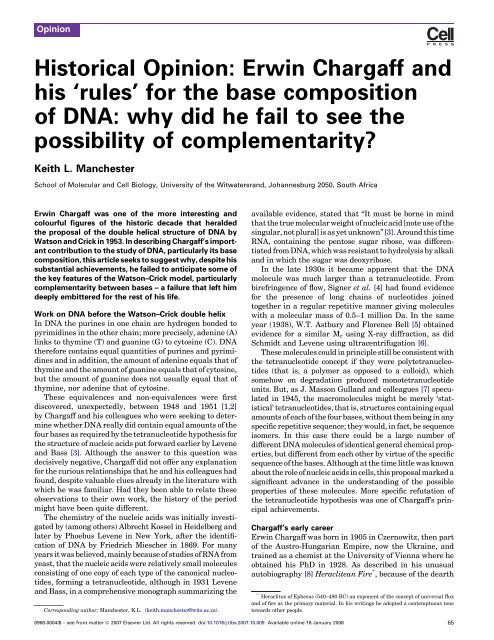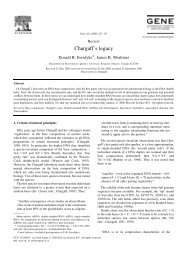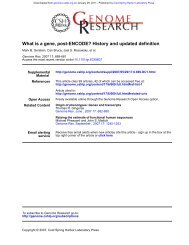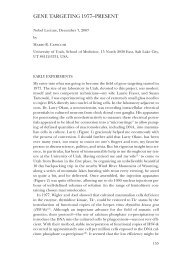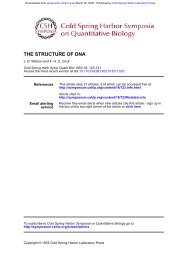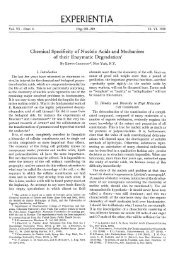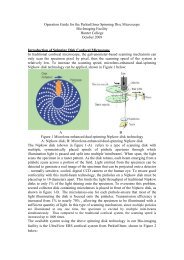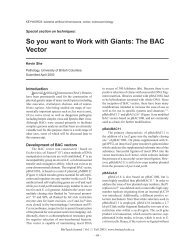Historical Opinion: Erwin Chargaff and his 'rules' for the ... - Biology
Historical Opinion: Erwin Chargaff and his 'rules' for the ... - Biology
Historical Opinion: Erwin Chargaff and his 'rules' for the ... - Biology
Create successful ePaper yourself
Turn your PDF publications into a flip-book with our unique Google optimized e-Paper software.
<strong>Opinion</strong><strong>Historical</strong> <strong>Opinion</strong>: <strong>Erwin</strong> <strong>Chargaff</strong> <strong>and</strong><strong>his</strong> ‘rules’ <strong>for</strong> <strong>the</strong> base compositionof DNA: why did he fail to see <strong>the</strong>possibility of complementarity?Keith L. ManchesterSchool of Molecular <strong>and</strong> Cell <strong>Biology</strong>, University of <strong>the</strong> Witwatersr<strong>and</strong>, Johannesburg 2050, South Africa<strong>Erwin</strong> <strong>Chargaff</strong> was one of <strong>the</strong> more interesting <strong>and</strong>colourful figures of <strong>the</strong> <strong>his</strong>toric decade that heralded<strong>the</strong> proposal of <strong>the</strong> double helical structure of DNA byWatson <strong>and</strong> Crick in 1953. In describing <strong>Chargaff</strong>’s importantcontribution to <strong>the</strong> study of DNA, particularly its basecomposition, t<strong>his</strong> article seeks to suggest why, despite <strong>his</strong>substantial achievements, he failed to anticipate some of<strong>the</strong> key features of <strong>the</strong> Watson–Crick model, particularlycomplementarity between bases – a failure that left himdeeply embittered <strong>for</strong> <strong>the</strong> rest of <strong>his</strong> life.Work on DNA be<strong>for</strong>e <strong>the</strong> Watson–Crick double helixIn DNA <strong>the</strong> purines in one chain are hydrogen bonded topyrimidines in <strong>the</strong> o<strong>the</strong>r chain; more precisely, adenine (A)links to thymine (T) <strong>and</strong> guanine (G) to cytosine (C). DNA<strong>the</strong>re<strong>for</strong>e contains equal quantities of purines <strong>and</strong> pyrimidines<strong>and</strong> in addition, <strong>the</strong> amount of adenine equals that ofthymine <strong>and</strong> <strong>the</strong> amount of guanine equals that of cytosine,but <strong>the</strong> amount of guanine does not usually equal that ofthymine, nor adenine that of cytosine.These equivalences <strong>and</strong> non-equivalences were firstdiscovered, unexpectedly, between 1948 <strong>and</strong> 1951 [1,2]by <strong>Chargaff</strong> <strong>and</strong> <strong>his</strong> colleagues who were seeking to determinewhe<strong>the</strong>r DNA really did contain equal amounts of <strong>the</strong>four bases as required by <strong>the</strong> tetranucleotide hypo<strong>the</strong>sis <strong>for</strong><strong>the</strong> structure of nucleic acids put <strong>for</strong>ward earlier by Levene<strong>and</strong> Bass [3]. Although <strong>the</strong> answer to t<strong>his</strong> question wasdecisively negative, <strong>Chargaff</strong> did not offer any explanation<strong>for</strong> <strong>the</strong> curious relationships that he <strong>and</strong> <strong>his</strong> colleagues hadfound, despite valuable clues already in <strong>the</strong> literature withwhich he was familiar. Had <strong>the</strong>y been able to relate <strong>the</strong>seobservations to <strong>the</strong>ir own work, <strong>the</strong> <strong>his</strong>tory of <strong>the</strong> periodmight have been quite different.The chemistry of <strong>the</strong> nucleic acids was initially investigatedby (among o<strong>the</strong>rs) Albrecht Kossel in Heidelberg <strong>and</strong>later by Phoebus Levene in New York, after <strong>the</strong> identificationof DNA by Friedrich Miescher in 1869. For manyyears it was believed, mainly because of studies of RNA fromyeast, that <strong>the</strong> nucleic acids were relatively small moleculesconsisting of one copy of each type of <strong>the</strong> canonical nucleotides,<strong>for</strong>ming a tetranucleotide, although in 1931 Levene<strong>and</strong> Bass, in a comprehensive monograph summarizing <strong>the</strong>Corresponding author: Manchester, K.L. (keith.manchester@wits.ac.za).available evidence, stated that ‘‘It must be borne in mindthat <strong>the</strong> true molecular weight of nucleic acid [note use of <strong>the</strong>singular, not plural] is as yet unknown’’ [3]. Around t<strong>his</strong> timeRNA, containing <strong>the</strong> pentose sugar ribose, was differentiatedfrom DNA, which was resistant to hydrolysis by alkali<strong>and</strong> in which <strong>the</strong> sugar was deoxyribose.In <strong>the</strong> late 1930s it became apparent that <strong>the</strong> DNAmolecule was much larger than a tetranucleotide. Frombirefringence of flow, Signer et al. [4] had found evidence<strong>for</strong> <strong>the</strong> presence of long chains of nucleotides joinedtoge<strong>the</strong>r in a regular repetitive manner giving moleculeswith a molecular mass of 0.5–1 million Da. In <strong>the</strong> sameyear (1938), W.T. Astbury <strong>and</strong> Florence Bell [5] obtainedevidence <strong>for</strong> a similar M r using X-ray diffraction, as didSchmidt <strong>and</strong> Levene using ultracentrifugation [6].These molecules could in principle still be consistent with<strong>the</strong> tetranucleotide concept if <strong>the</strong>y were polytetranucleotides(that is, a polymer as opposed to a colloid), whichsomehow on degradation produced monotetranucleotideunits. But, as J. Masson Gull<strong>and</strong> <strong>and</strong> colleagues [7] speculatedin 1945, <strong>the</strong> macromolecules might be merely ‘statistical’tetranucleotides, that is, structures containing equalamounts of each of <strong>the</strong> four bases, without <strong>the</strong>m being in anyspecific repetitive sequence; <strong>the</strong>y would, in fact, be sequenceisomers. In t<strong>his</strong> case <strong>the</strong>re could be a large number ofdifferent DNA molecules of identical general chemical properties,but different from each o<strong>the</strong>r by virtue of <strong>the</strong> specificsequence of <strong>the</strong> bases. Although at <strong>the</strong> time little was knownabout <strong>the</strong> role of nucleic acids in cells, t<strong>his</strong> proposal marked asignificant advance in <strong>the</strong> underst<strong>and</strong>ing of <strong>the</strong> possibleproperties of <strong>the</strong>se molecules. More specific refutation of<strong>the</strong> tetranucleotide hypo<strong>the</strong>sis was one of <strong>Chargaff</strong>’s principalachievements.<strong>Chargaff</strong>’s early career<strong>Erwin</strong> <strong>Chargaff</strong> was born in 1905 in Czernowitz, <strong>the</strong>n partof <strong>the</strong> Austro-Hungarian Empire, now <strong>the</strong> Ukraine, <strong>and</strong>trained as a chemist at <strong>the</strong> University of Vienna where heobtained <strong>his</strong> PhD in 1928. As described in <strong>his</strong> unusualautobiography [8] Heraclitean Fire * , because of <strong>the</strong> dearth* Heraclitus of Ephesus (540–480 BC) an exponent of <strong>the</strong> concept of universal flux<strong>and</strong> of fire as <strong>the</strong> primary material. In <strong>his</strong> writings he adopted a contemptuous tonetowards o<strong>the</strong>r people.0968-0004/$ – see front matter ß 2007 Elsevier Ltd. All rights reserved. doi:10.1016/j.tibs.2007.10.009 Available online 18 January 2008 65
<strong>Opinion</strong> Trends in Biochemical Sciences Vol.33 No.2of opportunities in Europe he went to Yale Universitywhere he stayed <strong>for</strong> two years studying <strong>the</strong> chemicalcomposition of <strong>the</strong> avian tubercle bacilli (Mycobacteriumavium).<strong>Chargaff</strong>’s arrival in <strong>the</strong> US was not without incidentbecause <strong>the</strong> immigration officials in New York could notunderst<strong>and</strong> how someone whose passport described him asDr Phil. would be coming to work on a ‘student visa’. They<strong>the</strong>re<strong>for</strong>e consigned him to Ellis Isl<strong>and</strong>, where he wasrescued by Treat Johnson, <strong>the</strong> head of <strong>the</strong> Yale chemistrydepartment. <strong>Chargaff</strong> returned from <strong>the</strong> US to Europe in<strong>the</strong> summer of 1930. He <strong>the</strong>n spent two <strong>and</strong> a half years inwhat he claims to have been <strong>the</strong> happiest period in <strong>his</strong> lifeworking with Martin Hahn at <strong>the</strong> Institute of Hygiene <strong>and</strong>Bacteriology in <strong>the</strong> University of Berlin, working again onbacterial lipids, t<strong>his</strong> time from Bacillus Calmette-Guérin(Mycobacterium bovis) <strong>and</strong> <strong>the</strong> phosphatide fraction ofdiph<strong>the</strong>ria bacteria.Reading <strong>the</strong> signs of <strong>the</strong> times in Germany <strong>and</strong> at <strong>the</strong>invitation of Albert Calmette, deputy director of <strong>the</strong> PasteurInstitute, <strong>Chargaff</strong> moved to Paris in 1933, but foundworking conditions difficult. At <strong>the</strong> end of 1934 he returnedto <strong>the</strong> US, helped by Harry Sobotka who was in charge ofbiochemistry at Mount Sinai Hospital. In 1935 he moved toHans Clarke’s Department of Biochemistry at <strong>the</strong> Collegeof Physicians <strong>and</strong> Surgeons at Columbia University. Herehe remained <strong>for</strong> <strong>the</strong> remainder of <strong>his</strong> working life. Hebecame full professor at <strong>the</strong> age of 47 <strong>and</strong> served asDepartment Chair from 1970–1974, retiring in 1974,embittered at <strong>the</strong> amount of <strong>his</strong> pension <strong>and</strong> at not havingbeen made a single offer to go elsewhere in 50 years! Over<strong>the</strong> years he travelled widely <strong>and</strong> received many honours<strong>and</strong> awards. He died in 2002, aged 96.Between 1936 <strong>and</strong> 1948 he published a large number ofpapers on various aspects of blood coagulation <strong>and</strong> on <strong>the</strong>biological use of labelled phosphorus in tracing metabolicFigure 1. Schematic representation of <strong>the</strong> position of <strong>the</strong> purines <strong>and</strong> pyrimidines on a paper chromatogram, following <strong>the</strong> separation of a mixture. What is shown here is acomposite figure summarizing analyses per<strong>for</strong>med under different running buffer conditions. In each instance <strong>the</strong> same mixture of bases was applied at <strong>the</strong> horizontalposition corresponding to R F (distance moved by sample) 0.00 <strong>and</strong> solvent was allowed to pass from <strong>the</strong> top of <strong>the</strong> sheet to <strong>the</strong> bottom. Under <strong>the</strong>se conditions <strong>the</strong> differentbases move down <strong>the</strong> sheet at different rates, but it can be seen that thymine (T) always moves faster than adenine (A), which moves faster than cytosine (C), which movesfaster than guanine (G). H st<strong>and</strong>s <strong>for</strong> hypoxanthine, X <strong>for</strong> xanthine, <strong>and</strong> U <strong>for</strong> uracil which is present in RNA in place of thymine; <strong>the</strong> pyrimidines are represented by openspots <strong>and</strong> <strong>the</strong> purines by closed spots. When <strong>the</strong> run is finished, <strong>the</strong> position of <strong>the</strong> bases can be recognized from <strong>the</strong>ir ultraviolet absorbance. The bases can be individuallyeluted <strong>and</strong> <strong>the</strong>ir concentration determined. The letters beneath <strong>the</strong> figure indicate <strong>the</strong> conditions <strong>and</strong> solvents used in <strong>the</strong> separations: a, acidic; n, neutral; B, n-butanol; M,morpholine; D, diethylene glycol; Co, collidine; Q, quinoline. Reproduced from Ref. [12].66
<strong>Opinion</strong> Trends in Biochemical Sciences Vol.33 No.2pathways. However, during World War II because of acontract with <strong>the</strong> Army Medical Service, he worked on<strong>the</strong> chemistry of <strong>the</strong> nucleic acid of Rickettsia. In 1944 <strong>his</strong>attention was drawn to <strong>the</strong> famous paper of Oswald Avery<strong>and</strong> colleagues [9], which was to trans<strong>for</strong>m our thinkingabout <strong>the</strong> role <strong>and</strong> importance of nucleic acids in cells, <strong>and</strong>in which <strong>the</strong> authors concluded that a nucleic acid of <strong>the</strong>desoxyribose y type (that is, DNA) is <strong>the</strong> fundamental unitof <strong>the</strong> trans<strong>for</strong>ming principle of Pneumococcus Type III.Around <strong>the</strong> same time <strong>Chargaff</strong> had been reading <strong>Erwin</strong>Schrödinger’s seminal book What is Life?, a work thatseems to have been inspirational to many physical scientistsof <strong>the</strong> period who were interested in biology, <strong>and</strong> inwhich Schrödinger suggested that chromosomes containsome kind of code-script [10].Hereditary code-script, chromosomes, genes composedof DNA which, if not a rigid tetranucleotide, was able toexist in extremely large numbers of different sequences:<strong>the</strong> stage was set. If DNA were a crucial part of t<strong>his</strong>assemblage, it was essential that more be learned aboutits chemistry. As <strong>Chargaff</strong> later stated, ‘Avery gave us <strong>the</strong>first text of a new language, or ra<strong>the</strong>r he showed us whereto look <strong>for</strong> it. I resolved to search <strong>for</strong> t<strong>his</strong> text’ [8].Analysis of DNAIn 1944 Consden et al. [11] showed that it was possible toseparate individual amino acids <strong>and</strong> to determine <strong>the</strong>amino acid composition of protein hydrolysates bypartition chromatography on paper strips. The methodwas, in principle, readily adapted <strong>for</strong> <strong>the</strong> separation <strong>and</strong>identification of a large number of o<strong>the</strong>r substances, including<strong>the</strong> purines <strong>and</strong> pyrimidines of <strong>the</strong> nucleic acids(Figure 1), a task carried out in <strong>Chargaff</strong>’s laboratory by<strong>the</strong> Swiss post-doctoral fellow Ernst Vischer [12], <strong>and</strong>independently at <strong>the</strong> Rockefeller Institute by Rollin Hotchkiss[13].<strong>Chargaff</strong>’s group published numerous papers on <strong>the</strong>base composition of DNA isolated from different species<strong>and</strong>, where appropriate, made comparisons of <strong>the</strong> basecomposition of DNA from different tissues of <strong>the</strong> samespecies. The data generally showed that <strong>the</strong> bases werenot present in equimolar proportions in <strong>the</strong> various DNApreparations as required by <strong>the</strong> tetranucleotide hypo<strong>the</strong>sis[3]. Initial results from animal tissues, which showedsimilar amounts of <strong>the</strong> four bases in different tissues from<strong>the</strong> same species [14], all demonstrated an excess of A <strong>and</strong>T over G <strong>and</strong> C (Table 1).To widen <strong>the</strong> range of <strong>the</strong>se findings, <strong>the</strong> authorsreasoned that ‘‘if as appears probable, certain nucleic acidsare endowed with a specific biological activity (Avery et al.’sdiscovery [9]), a search <strong>for</strong> chemical differences in nucleicacids derived from taxonomically different species shouldbe conducted, <strong>and</strong> microorganisms would appear to be oneof <strong>the</strong> most promising sources’’ [15]. T<strong>his</strong> is highlighted inTable 1. Saccharomyces cerevisiae <strong>and</strong> Haemophilus influenzaecontained an even higher excess of A <strong>and</strong> T over G<strong>and</strong> C [15], whereas Serratia marcescens <strong>and</strong> BacillusSchatz revealed considerably lower amounts of A <strong>and</strong> Ty Note, in <strong>the</strong> period under discussion some journals preferred <strong>the</strong> use of <strong>the</strong> term‘desoxyribose’ as opposed to <strong>the</strong> accepted usage today of ‘deoxyribose’.Table 1. Molar proportions of purines <strong>and</strong> pyrimidines in DNAfrom different species <strong>and</strong> organisms aSpecies A/G T/C Pu/PyOx Bos taurus 1.29 1.43 1.1Man Homo sapiens 1.56 1.75 1.0Wheatgerm Triticum vulgare 1.22 1.18 1.0Yeast Saccharomyces cerevsiae 1.72 1.9 1.0Avian tubercle bacillus0.4 0.4 1.1(Mycobacterium avium)Haemophilus influenzae, Type C 1.74 1.54 1.0Escherichia coli, K-12 1.05 0.95 1.0Serratia Marcescens 0.7 0.7 0.9Hydrogen organism Bacillus Schatz 0.7 0.6 1.0a Adapted from Tables 4 from [2] <strong>and</strong> [21]. The third column is <strong>the</strong> ratio of purines topyrimidines.than of G <strong>and</strong> C [16]. Escherichia coli contained roughlyequal amounts of <strong>the</strong> four bases [17]. Perversely, had itbeen <strong>the</strong> only microorganism studied, it would have offeredsupport <strong>for</strong> <strong>the</strong> tetranucleotide hypo<strong>the</strong>sis, which might<strong>the</strong>reby have gained a new lease on life.Apart from not demonstrating equal amounts of <strong>the</strong> fourbases <strong>and</strong> thus casting doubt on <strong>the</strong> validity of <strong>the</strong> tetranucleotidehypo<strong>the</strong>sis, certain o<strong>the</strong>r unexpected patternsalso emerged: <strong>the</strong> amounts of purines seemed always toequal those of pyrimidines (that is, A + G = C + T, or(A + G)/(C + T) = 1). T<strong>his</strong> had been found by Alfred Mirsky[18] in 1943, but seems to have been overlooked by <strong>the</strong><strong>Chargaff</strong> laboratory. More curiously, <strong>the</strong> ratios of A:G <strong>and</strong>T:C were always similar to each o<strong>the</strong>r whe<strong>the</strong>r <strong>the</strong>y weregreater or less than 1 (Table 1).The significance of <strong>the</strong>se relationships was puzzling <strong>and</strong>a constant source of comment. At <strong>the</strong> end of 1949 <strong>Chargaff</strong>noted that ‘‘A comparison of <strong>the</strong> molar proportions [of <strong>the</strong>bases] reveals certain striking, but perhaps meaningless,regularities’’ [15]. Early in 1950, he wrote ‘‘It is noteworthy,although possibly no more than accidental, that in alldesoxypentose nucleic acids examined thus far <strong>the</strong> molarratios of total purines to total pyrimidines were not farfrom 1. More should not be read into <strong>the</strong>se figures.’’ [19]Later in 1950, apparently as a last-minute insertion in <strong>the</strong>paper, <strong>Chargaff</strong> wrote ‘‘It is noteworthy – whe<strong>the</strong>r t<strong>his</strong> ismore than accidental, cannot yet be said – that in alldesoxypentose nucleic acids examined thus far <strong>the</strong> molarratios of total purines <strong>and</strong> total pyrimidines, <strong>and</strong> also ofadenine to thymine <strong>and</strong> of guanine to cytosine [ratioscuriously not actually presented], were not far from 1’’[2]. The following year, he wrote ‘‘As <strong>the</strong> number ofexamples of such regularity increases, <strong>the</strong> question willbecome pertinent whe<strong>the</strong>r it is merely accidental orwhe<strong>the</strong>r it is an expression of certain structural principlesthat are shared by many desoxypentose nucleic acids,despite far-reaching differences in <strong>the</strong>ir individual composition<strong>and</strong> <strong>the</strong> absence of a recognizable periodicity in <strong>the</strong>irnucleotide sequence’’ [20]. He <strong>the</strong>n added ‘‘It is believedthat <strong>the</strong> time has not yet come to attempt an answer’’ [20],although clearly <strong>the</strong> subject was very much on <strong>his</strong> mind.<strong>Chargaff</strong>, unlike Astbury [5], seemed to be afraid ofbecoming immersed in <strong>the</strong>ories based on numerology.However, by <strong>the</strong> time of <strong>the</strong> Federation Meetings of1951, a table in <strong>Chargaff</strong>’s paper [21] containing <strong>the</strong> results<strong>for</strong> 11 different species shows inescapably that <strong>the</strong> ratios ofpurines to pyrimidines, A to T <strong>and</strong> G to C are all close to67
<strong>Opinion</strong> Trends in Biochemical Sciences Vol.33 No.2unity, whereas <strong>for</strong> only one organism (E. coli) can <strong>the</strong> samebe said <strong>for</strong> A to G <strong>and</strong> T to C. As he stated ‘it is almostimpossible to decide at present whe<strong>the</strong>r <strong>the</strong>se regularitiesare entirely <strong>for</strong>tuitous or whe<strong>the</strong>r <strong>the</strong>y reflect <strong>the</strong> existencein all DNA preparations of certain common structuralprinciples (my emphasis) irrespective of far-reachingdifferences in <strong>the</strong> individual composition <strong>and</strong> <strong>the</strong> absenceof an easily recognizable periodicity’ [21]. Later, in 1953, heremarked, ‘‘Ano<strong>the</strong>r relationship that again provedremarkably constant was <strong>the</strong> ratio of amino groups toenolic hydroxyl groups’’ [22]. However, <strong>the</strong> ratio here isapproximately 1.4 depending on base composition of <strong>the</strong>DNA, not 1, because G possesses an amino as well as anenolic hydroxyl group, resulting in an excess of <strong>the</strong> <strong>for</strong>mer.Just down <strong>the</strong> road from <strong>Chargaff</strong> at <strong>the</strong> RockefellerInstitute, Mirsky <strong>and</strong> associates (who, as already mentioned,had previously found that DNA from plants <strong>and</strong>animals contained equal quantities of purines <strong>and</strong> pyrimidines[18]), in 1950 published a detailed analysis of DNAfrom numerous animal sources, wheat germ <strong>and</strong> PneumococcusType III [23], finding similar compositions <strong>for</strong> eachspecies. As <strong>the</strong>y pointed out, because A was clearly notequal to G, <strong>and</strong> T to C, <strong>the</strong> results rendered <strong>the</strong> tetranucleotidehypo<strong>the</strong>sis untenable, but <strong>the</strong>y did not commenton <strong>the</strong> now obvious 1:1 ratios of A:T <strong>and</strong> G:C that were, ifanything, clearer in <strong>the</strong>ir figures than in many of <strong>the</strong><strong>Chargaff</strong> papers. It was most un<strong>for</strong>tunate that Mirsky’sstudies did not include <strong>the</strong> organisms that <strong>Chargaff</strong> foundto possess such markedly different compositions to mammalian<strong>and</strong> o<strong>the</strong>r species (Table 1) because it would beinteresting to know what conclusions would <strong>the</strong>n havebeen drawn.What could base equivalencies mean?Given <strong>his</strong> significant achievements, how was it that <strong>Chargaff</strong>did not make <strong>the</strong> conceptual jump to realize that <strong>the</strong>equality of amounts of A <strong>and</strong> T, a purine <strong>and</strong> a pyrimidine,<strong>and</strong> G <strong>and</strong> C, also a purine <strong>and</strong> a pyrimidine – equalitiesthat seemed to hold in all different organisms despite largevariations in ratios of A to G <strong>and</strong> C to T – had its origin insome fundamental feature of <strong>the</strong> general structure ofDNA? Surely he did, but as Horace Judson suggests, ‘‘itwas not easy to see how at <strong>the</strong> time he could have understood<strong>the</strong> significance of <strong>the</strong> equivalence rule or taken itany fur<strong>the</strong>r... it remains that he did not take it fur<strong>the</strong>r’’[24]. Wilkins suggested that it was <strong>the</strong> negative influenceof Levene <strong>and</strong> Levene’s conviction that DNA was too simplea compound to contain genetic in<strong>for</strong>mation that made<strong>Chargaff</strong> over-cautious about considering that <strong>the</strong> basesmight be paired [25]. T<strong>his</strong> is possible, but a chemist wouldhave been keen to solve a structure <strong>for</strong> its own sake.Moreover, because <strong>Chargaff</strong> regarded Avery’s work as<strong>the</strong> inspiration <strong>for</strong> <strong>his</strong> own studies, Wilkins’s commentfalls away.In 1947, Gull<strong>and</strong>, professor of chemistry in Nottingham,carefully extracted DNA from nucleoprotein under conditionsin which nei<strong>the</strong>r acid nor alkali were used [26].Electrometric titration of material so prepared suggested<strong>the</strong> presence of many hydrogen bonds in <strong>the</strong> native DNAmolecule between <strong>the</strong> amino groups of A <strong>and</strong> C, <strong>and</strong> <strong>the</strong>enolic groups of G <strong>and</strong> T. Careful titration with acid oralkali disrupted <strong>the</strong>se bonds <strong>and</strong> <strong>the</strong> pH of <strong>the</strong> most rapiduptake or loss of protons coincided with a dramaticdecrease in <strong>the</strong> viscosity of <strong>the</strong> solution [27], a phenomenonsuggesting that <strong>the</strong> hydrogen bonding lay between bases indifferent chains. Had <strong>Chargaff</strong> taken more cognizance of<strong>the</strong> little-appreciated but highly relevant findings of Gull<strong>and</strong>et al. in 1947 [26,27] regarding <strong>the</strong> probable existenceof hydrogen bonding between bases in DNA in solution, hemight have had a major intuitive realization of <strong>the</strong> originof, <strong>and</strong> reason <strong>for</strong>, <strong>his</strong> observed base ratios.Gull<strong>and</strong>’s work was well known to <strong>Chargaff</strong>. They hadboth attended <strong>the</strong> Cold Spring Harbor conference in 1947where Gull<strong>and</strong> made an extensive presentation describinginter-chain hydrogen bonding [28]. It is very strange that<strong>Chargaff</strong> never sought to relate <strong>his</strong> own findings concerning<strong>the</strong> quantitative relationships of base composition tothose of <strong>the</strong> hydrogen bonding between chains. If Gull<strong>and</strong>’swork was to be believed, <strong>the</strong> hydrogen bonds existedbetween <strong>the</strong> bases, thus suggesting bonding between A<strong>and</strong> T <strong>and</strong> between G <strong>and</strong> C, a situation that would also beconsistent with a purine always bonding to a pyrimidine. Ifsuch bonding were between bases in different chains itwould suggest a degree of complementarity in basesequence – a finding with exciting implications. He mightindeed have been <strong>the</strong> first to write that ‘‘it has not escapedour notice that <strong>the</strong> specific pairing we have postulated(<strong>Chargaff</strong> might have used <strong>the</strong> word ‘observed’) immediatelysuggests a possible copying mechanism <strong>for</strong> <strong>the</strong>genetic material’’ [29].In 1948 <strong>Chargaff</strong> wrote a chapter on nucleic acids in <strong>the</strong>Annual Reviews of Biochemistry [30], surveying <strong>the</strong> newin<strong>for</strong>mation published between 1945 <strong>and</strong> 1947. Although<strong>Chargaff</strong> commences ‘‘with a tribute of <strong>the</strong> memory of J.M.Gull<strong>and</strong> – <strong>his</strong> death means a sad <strong>and</strong> irreparable loss to usall’’ [30] (Gull<strong>and</strong> tragically died in a railway accident in1947), <strong>his</strong> seminal work published in 1947 of <strong>the</strong> existenceof hydrogen bonds between bases in DNA in solutionreceived only cursory mention. It is as though <strong>Chargaff</strong>had a specific mental block towards t<strong>his</strong> work <strong>and</strong> itsimplications, which were so relevant to <strong>his</strong> own findings.Unlike Watson a few years later [31], <strong>Chargaff</strong> did notseem to have experienced any revelatory insight from <strong>the</strong>reading or re-reading of Gull<strong>and</strong>’s papers.Chains <strong>and</strong> base-pairingBe<strong>for</strong>e Watson <strong>and</strong> Crick’s paper in 1953 [29] <strong>the</strong>re was nodefinitive evidence <strong>for</strong> a specific number of chains in a DNAmolecule. If one considers a single polynucleotide str<strong>and</strong> itis difficult to think what significance equal quantities of A<strong>and</strong> T, on <strong>the</strong> one h<strong>and</strong>, <strong>and</strong> G <strong>and</strong> C on <strong>the</strong> o<strong>the</strong>r, couldhave. With hindsight it is so easy to see <strong>the</strong> connectionbetween base pairing <strong>and</strong> a double helix, <strong>and</strong> how complementarityarises, that we now have difficulty in recognizing<strong>the</strong> initial feat of realizing t<strong>his</strong>. As Linus Paulingcommented regarding <strong>the</strong> many years during which hepondered <strong>the</strong> folding of polypeptide chains, ‘even ra<strong>the</strong>rsimple ideas are sometimes very elusive’ [32]. IndeedPauling <strong>and</strong> Corey perceived nothing in <strong>Chargaff</strong>’s data(or in <strong>the</strong> results of Gull<strong>and</strong> et al. on hydrogen bonding, <strong>for</strong>that matter) relevant to <strong>the</strong>ir impossible proposed structure<strong>for</strong> <strong>the</strong> DNA molecule [33] in which <strong>the</strong>y had led68
<strong>Opinion</strong> Trends in Biochemical Sciences Vol.33 No.2<strong>the</strong>mselves astray by implicitly assuming that DNA wouldpossess similar structural features to <strong>the</strong>ir protein a helix.Curiously <strong>for</strong> a chemist with biochemical interests, <strong>the</strong>only biochemistry cited by Pauling <strong>and</strong> Corey was Alex<strong>and</strong>erTodd’s elucidation of <strong>the</strong> phosphodiester linkage ofnucleotides. Until 1953 <strong>the</strong> only published X-ray diffractionwork on DNA was that of Astbury [34], <strong>and</strong> t<strong>his</strong>provided no indication of <strong>the</strong> number of chains.In 1952 <strong>Chargaff</strong> visited Europe, including Cambridge,where John Kendrew arranged a meeting <strong>for</strong> him withWatson <strong>and</strong> Crick. According to Robert Olby’s account [35],when <strong>Chargaff</strong> described <strong>the</strong> 1:1 ratios between A <strong>and</strong> T<strong>and</strong> G <strong>and</strong> C, <strong>the</strong> effect on Crick was ‘electric’. Cricksuddenly realized that if <strong>the</strong>re is complementary pairing<strong>the</strong>re was sure to be a 1:1 ratio. At t<strong>his</strong> point Crick had<strong>for</strong>gotten <strong>the</strong> names of <strong>the</strong> bases, which did not impress<strong>Chargaff</strong>, who arrogantly considered that he was wasting<strong>his</strong> time talking to a couple of ‘pitchmen’ z . In fact at <strong>the</strong>time Crick was thinking less about <strong>the</strong> structure of DNAthan about mechanisms of DNA replication. He hadrecently been told by <strong>the</strong> young ma<strong>the</strong>matician John Griffiththat if <strong>the</strong> bases are flat <strong>and</strong> <strong>the</strong>y stack on top of eacho<strong>the</strong>r, under <strong>the</strong>se conditions <strong>the</strong>re is an (oddly) preferentialattraction between A <strong>and</strong> T <strong>and</strong> between G <strong>and</strong>C. But at <strong>the</strong> moment of meeting <strong>Chargaff</strong>, Crick apparentlyhad <strong>for</strong>gotten <strong>the</strong> details of what Griffith had toldhim. Presumably, had Crick remembered what Griffithhad found <strong>and</strong> had related it to <strong>Chargaff</strong>, <strong>the</strong> interestwould have been mutual. But in point of fact <strong>the</strong> conceptof preferential associations in base stacking parallel to <strong>the</strong>fibre axis was unlikely to have led ei<strong>the</strong>r <strong>Chargaff</strong> orWatson <strong>and</strong> Crick to any useful insights.Watson’s realization of <strong>the</strong> possibility of specific hydrogen-bondedpurine–pyrimidine base pairing explained <strong>the</strong><strong>Chargaff</strong> rules ra<strong>the</strong>r than vice-versa because <strong>Chargaff</strong>failed to relate Gull<strong>and</strong>’s findings of <strong>the</strong> existence of hydrogenbonding between bases with <strong>the</strong> base ratios he wasobserving. T<strong>his</strong> seems to be <strong>the</strong> crux of <strong>the</strong> matter.<strong>Chargaff</strong>’s achievementsIn Heraclitean Fire [8] <strong>Chargaff</strong> summarized <strong>his</strong> findings.‘The regularities of <strong>the</strong> composition of DNAs – somefriendly people later called <strong>the</strong>m <strong>the</strong> ‘<strong>Chargaff</strong> rules’ –are as follows: (a) <strong>the</strong> sum of <strong>the</strong> purines (adenine <strong>and</strong>guanine) equals that of <strong>the</strong> pyrimidines (cytosine <strong>and</strong>thymine); (b) <strong>the</strong> molar ratio of adenine to thymine equals1; (c) <strong>the</strong> molar ratio of guanine to cytosine equals 1. And,as a direct consequence of <strong>the</strong>se relationships, (d) <strong>the</strong>number of 6-amino groups (adenine <strong>and</strong> cytosine) is <strong>the</strong>same as that of 6-keto groups (guanine <strong>and</strong> thymine)’ [8].Of course (a) is a direct consequence of (b) <strong>and</strong> (c). Curiously,in <strong>the</strong> tables of <strong>Chargaff</strong>’s papers <strong>the</strong> only ratiosusually presented are A:G, T:C <strong>and</strong> A:C, rarely <strong>the</strong> crucialA:T <strong>and</strong> G:C. In <strong>the</strong> preface to <strong>his</strong> book Essays on NucleicAcids [36], <strong>Chargaff</strong> states, ‘‘It will surprise many readers...tolearn that <strong>the</strong> first announcement of base-pairingwas made in 1950’’, but where it was made is not indicated.Moreover, <strong>the</strong>re is a major distinction between basez ‘Pitchmen’ – a double entendre relating to salesmen (who pitch) <strong>and</strong> a preoccupationof Watson <strong>and</strong> Crick in <strong>the</strong>ir discussion with <strong>Chargaff</strong> of <strong>the</strong> pitch of a helix.pairing of unknown significance <strong>and</strong> a structural interactionbetween specific bases such as Watson <strong>and</strong> Crick proposed.Heraclitian Fire, written when <strong>Chargaff</strong> was in <strong>his</strong> 70s,is enjoyable reading in <strong>the</strong> earlier chapters describing <strong>his</strong>youth <strong>and</strong> early life in Austria, <strong>the</strong>n at Yale, Berlin <strong>and</strong>Paris, but it later degenerates into a monotonous polemicagainst <strong>the</strong> modern world, particularly <strong>the</strong> scientific realm,made famous by <strong>the</strong> nonsensical phrase that molecularbiology is ‘‘practicing biochemistry without a licence’’ [8].<strong>Chargaff</strong> also reflected on <strong>his</strong> style of science – ‘‘In someways I was <strong>the</strong> wrong man to make <strong>the</strong>se discoveries:imaginative ra<strong>the</strong>r than analytical; apocalyptic ra<strong>the</strong>rthan dogmatic; brought up to despise publicity; uncom<strong>for</strong>tablein scientific ga<strong>the</strong>rings; fleeing all contacts; alwayshappier with my youngers than with my betters; moreafraid of an absurd world than trying to underst<strong>and</strong> it;but ever conscious, day <strong>and</strong> night, that <strong>the</strong>re is more to seethan I can see, more to say than I can say, <strong>and</strong> even more tobe silent about’’ [8]. Does all t<strong>his</strong> merely attempt to mask<strong>the</strong> bitterness he felt that he was never able to make aconceptual leap to <strong>the</strong> significance of <strong>the</strong> various baseratios he had observed?Conclusion<strong>Chargaff</strong>’s failure to ‘see’ base pairing overshadows <strong>his</strong>contributions to nucleic acid chemistry. He was <strong>the</strong> firstto develop micro-methods <strong>for</strong> <strong>the</strong> accurate analysis ofpurines <strong>and</strong> pyrimidines <strong>and</strong> hence <strong>the</strong> base compositionof nucleic acids. He recognized that DNA in its basecomposition is characteristic of <strong>the</strong> species from which itis derived <strong>and</strong> that different tissues of <strong>the</strong> same speciesyield <strong>the</strong> same DNA. He also showed that lack of equality of<strong>the</strong> four bases in most samples of DNA invalidated <strong>the</strong>tetranucleotide hypo<strong>the</strong>sis <strong>and</strong> opened <strong>the</strong> way to <strong>the</strong>realization that different DNA molecules could havespecific base sequences, a possibility already anticipatedby Gull<strong>and</strong> <strong>and</strong> colleagues with <strong>the</strong>ir statistical tetranucleotideconcept [7].Could it be that, as was said of Avery, ‘constant modesty<strong>and</strong> deep humility..(<strong>and</strong>) high regard <strong>for</strong> <strong>the</strong> printed worddeterred him from <strong>the</strong>orizing in print’ [37], or might it havebeen an arrogance born of <strong>the</strong> belief that nobody else couldpossibly know more on <strong>the</strong> subject than he? Un<strong>for</strong>tunately<strong>and</strong> sadly we shall never know, but somehow <strong>Chargaff</strong>succeeded in excluding himself from one of <strong>the</strong> greatscientific breakthroughs of <strong>the</strong> 20th century.References1 <strong>Chargaff</strong>, E. (1950) Chemical specificity of nucleic acids <strong>and</strong> mechanismof <strong>the</strong>ir enzymatic degradation. Experientia 6, 201–2092 <strong>Chargaff</strong>, E. (1951) Some recent studies on <strong>the</strong> composition <strong>and</strong>structure of nucleic acids. J. Cell. Comp. Physiol. 38 (suppl. 1), 41–593 Levene, P.A. <strong>and</strong> Bass, L.W. (1931) Nucleic Acids, Chemical Catalog.Co., New York4 Signer, R. et al. (1938) Molecular shape <strong>and</strong> size of thymonucleic acid.Nature 141, 1225 Astbury, W.T. (1947) X-Ray studies of nucleic acids. Symp. Soc. Exp.Biol. 1, 66–766 Schmidt, G. <strong>and</strong> Levene, P.A. (1938) The effect of nucleophosphatase on‘native’ <strong>and</strong> depolymerized thymonucleic acid. Science 88, 172–1737 Gull<strong>and</strong>, J.M. et al. (1945) The chemistry of <strong>the</strong> nucleic acids <strong>and</strong>nucleoproteins. Annu. Rev. Biochem. 14, 175–2068 <strong>Chargaff</strong>, E. (1978) Heraclitean Fire. Sketches from a life be<strong>for</strong>eNature. Rockefeller University Press69
<strong>Opinion</strong> Trends in Biochemical Sciences Vol.33 No.29 Avery, O.T. et al. (1944) Studies on <strong>the</strong> chemical nature of <strong>the</strong> substanceinducing trans<strong>for</strong>mation of pneumococcal types. Induction oftrans<strong>for</strong>mation by a desoxyribonucleic acid fraction isolated fromPneumococcus Type III. J. Exp. Med. 79, 137–15810 Schrödinger, E. (1944) What is Life? The Physical Aspect of <strong>the</strong> LivingCell, Cambridge University Press11 Consden, R. et al. (1944) Qualitative analysis of proteins: a partitionchromatographic method using paper. Biochem. J. 38, 224–23212 Vischer, E. <strong>and</strong> <strong>Chargaff</strong>, E. (1948) The separation <strong>and</strong> quantitativeestimation of purines <strong>and</strong> pyrimidines in minute amounts. J. Biol.Chem. 176, 703–71413 Hotchkiss, R.D. (1948) The quantitative separation of purines,pyrimidines, <strong>and</strong> nucleosides by paper chromatography. J. Biol.Chem. 175, 315–33214 <strong>Chargaff</strong>, E. et al. (1949) The composition of <strong>the</strong> desoxypentose nucleicacids of thymus <strong>and</strong> spleen. J. Biol. Chem. 177, 405–41615 Vischer, E. et al. (1949) Microbial nucleic acids: The desoxypentosenucleic acids of avian tubercle bacilli <strong>and</strong> yeast. J. Biol. Chem. 177,429–43816 <strong>Chargaff</strong>, E. et al. (1950) Bacterial desoxypentose nucleic acids ofunusual composition. J. Am. Chem. Soc. 72, 382517 G<strong>and</strong>elman, B. et al. (1952) The desoxypentose nucleic acids of threestrains of Escherichia coli. Biochim. Biophys. Acta 9, 399–40118 Mirsky, A.E. (1943) Chromosomes <strong>and</strong> nucleoproteins. Adv. Enzymol.3, 1–3419 <strong>Chargaff</strong>, E. et al. (1950) Composition of human desoxypentose nucleicacid. Nature 165, 756–75720 <strong>Chargaff</strong>, E. et al. (1951) The composition of <strong>the</strong> desoxyribonucleic acidof salmon sperm. J. Biol. Chem. 192, 223–23021 <strong>Chargaff</strong>, E. (1951) Structure <strong>and</strong> function of nucleic acids as cellconstituents. Fed. Proc. 10, 654–65922 <strong>Chargaff</strong>, E. <strong>and</strong> Lipshitz, R. (1953) Composition of mammali<strong>and</strong>esoxyribonucleic acids. J. Am. Chem. Soc. 75, 3658–366123 Daly, M.M. et al. (1950) Purine <strong>and</strong> pyrimidine contents of somedesoxypentose nucleic acids. J. Gen. Physiol. 33, 497–51024 Judson, H.F. (1979) The Eighth Day of Creation, Simon <strong>and</strong> Schuster25 Wilkins, M. (2003) The Third Man of <strong>the</strong> Double Helix, Ox<strong>for</strong>dUniversity Press, pp 151–226 Gull<strong>and</strong>, J.M. et al. (1947) Deoxypentose nucleic acids. Part II.Electrometric titration of <strong>the</strong> acidic <strong>and</strong> <strong>the</strong> basic groups of <strong>the</strong>deoxypentose nucleic acid of calf thymus. J. Chem. Soc. 1131–114127 Creeth, J.M. et al. (1947) Deoxypentose nucleic acids. Part III. Viscosity<strong>and</strong> streaming birefringence of solutions of <strong>the</strong> sodium salt of <strong>the</strong>deoxypentose nucleic acid of calf thymus. J. Chem. Soc. 1141–114528 Gull<strong>and</strong>, J.M. (1948) The structure of nucleic acids. Cold Spring Harb.Symp. Quant. Biol. 12, 95–10129 Watson, J.D. <strong>and</strong> Crick, F.H.C. (1953) A structure <strong>for</strong> deoxyribosenucleic acid. Nature 171, 737–73830 <strong>Chargaff</strong>, E. <strong>and</strong> Vischer, E. (1948) Nucleoproteins, nucleic acids, <strong>and</strong>related substances. Annu. Rev. Biochem. 17, 201–22631 Watson, J.D. (1968) The Double Helix., Weidenfeld <strong>and</strong> Nicolson32 Pauling, L. (1974) Molecular basis of biological specificity. Nature 248,769–77133 Pauling, L. <strong>and</strong> Corey, R.B. (1953) A proposed structure <strong>for</strong> <strong>the</strong> nucleicacids. Proc. Natl. Acad. Sci. U. S. A. 39, 84–9734 Astbury, W.T. <strong>and</strong> Bell, F.O. (1938) Some recent developments in <strong>the</strong>X-ray study of proteins <strong>and</strong> related structures. Cold Spring Harb.Symp. Quant. Biol. 6, 108–11835 Olby, R.C. (1974) The Path to <strong>the</strong> Double Helix, Macmillan36 <strong>Chargaff</strong>, E. (1963) Essays on Nucleic Acids, Elsevier37 Coburn, A.F. (1969) Oswald Theodore Avery <strong>and</strong> DNA. Perspect. Biol.Med. 12, 623–630Elsevier.com – linking scientists to new research <strong>and</strong> thinkingDesigned <strong>for</strong> scientists’ in<strong>for</strong>mation needs, Elsevier.com is powered by <strong>the</strong> latest technology withcustomer-focused navigation <strong>and</strong> an intuitive architecture <strong>for</strong> an improved user experience <strong>and</strong>greater productivity.The easy-to-use navigational tools <strong>and</strong> structure connect scientists with vital in<strong>for</strong>mation – allfrom one entry point. Users can per<strong>for</strong>m rapid <strong>and</strong> precise searches with our advanced searchfunctionality, using <strong>the</strong> FAST technology of Scirus.com, <strong>the</strong> free science search engine. Users c<strong>and</strong>efine <strong>the</strong>ir searches by any number of criteria to pinpoint in<strong>for</strong>mation <strong>and</strong> resources. Search by aspecific author or editor, book publication date, subject area – life sciences, health sciences,physical sciences <strong>and</strong> social sciences – or by product type. Elsevier’s portfolio includes more than1800 Elsevier journals, 2200 new books every year <strong>and</strong> a range of innovative electronic products.In addition, tailored content <strong>for</strong> authors, editors <strong>and</strong> librarians provides timely news <strong>and</strong> updateson new products <strong>and</strong> services.Elsevier is proud to be a partner with <strong>the</strong> scientific <strong>and</strong> medical community. Find out more aboutour mission <strong>and</strong> values at Elsevier.com. Discover how we support <strong>the</strong> scientific, technical <strong>and</strong>medical communities worldwide through partnerships with libraries <strong>and</strong> o<strong>the</strong>r publishers, <strong>and</strong> grantawards from The Elsevier Foundation.As a world-leading publisher of scientific, technical <strong>and</strong> health in<strong>for</strong>mation, Elsevier is dedicated tolinking researchers <strong>and</strong> professionals to <strong>the</strong> best thinking in <strong>the</strong>ir fields. We offer <strong>the</strong> widest <strong>and</strong>deepest coverage in a range of media types to enhance cross-pollination of in<strong>for</strong>mation,breakthroughs in research <strong>and</strong> discovery, <strong>and</strong> <strong>the</strong> sharing <strong>and</strong> preservation of knowledge.Elsevier. Building insights. Breaking boundaries.www.elsevier.com70


